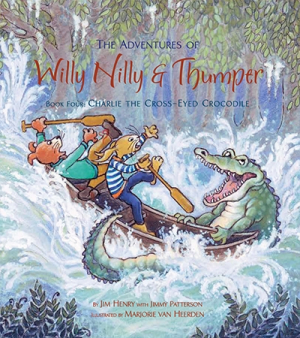Charlie the Cross-Eyed Crocodile
With well-crafted text and illustrations, Charlie the Cross-Eyed Crocodile is a worthy addition to the series.
Jim Henry and Jimmy Patterson present the story of a pair of friends who match wits with a predator in the handsome picture book Charlie the Cross-Eyed Crocodile.
Willy Nilly, a dog, and his buddy Thumper, a rabbit, are paddling in a canoe when when they’re noticed by Charlie, a crocodile who’d like nothing more than to eat the pair for dinner. Charlie knocks them out of the canoe, and the friends swim for land, climbing a tree for safety. Charlie waits at the bottom, first playing dead and finally retreating to the water, claiming injury, but Willy Nilly and Thumper aren’t fooled. Making a run for their canoe, they’re soon confronted by Charlie once again, and this time they jam a stick into his mouth to prop it open. Charlie begs for help removing the stick, and Willy Nilly and Thumper decide to oblige—from afar. Once freed, Charlie reneges on his promise not to chase them and is finally overcome by a paddle-strike to the head as the two friends escape, heading for home.
A sense of professionalism permeates the book, possibly the influence of Patterson, a journalist and writer who took a transcription of Henry’s recited story and delivered it in prose. Marjorie Van Heerden’s illustrations provide rich texture for the tale, and the editing is nearly flawless. There are a few minor oversights—more like assumptions of familiarity with the three prior Willy Nilly and Thumper books. For example, Willy Nilly seems to be a dog, but that fact isn’t confirmed until page ten, and the matter of which character is Thumper and which is Willy Nilly isn’t made apparent until later in the book.
The characters are likable and demonstrate an intelligent brand of compassion when they remove the stick from Charlie’s mouth by tying a long piece of vine to it and pulling from what seems to be a safe distance. Discussing their options, Willy Nilly convinces his friend Thumper to be charitable toward their enemy:
“You know what, Thump? We can’t leave him like that.”
“Sure we can. After all he’s put us through, leaving him there like that is exactly what I had in mind!”
“But it would be cruel, wouldn’t it?” asked Willy Nilly.
The question of whether Charlie can change, and whether he should be given the opportunity, is perhaps the key moment in the book—just the right hint of complexity to an otherwise enjoyable but fairly straightforward tale. “Notes from Willy Nilly and Thumper’s Library” proves a nice endpiece, an appendix of facts and illustrations about elements from the story, including river ecosystems, canoes, and crocodiles.
With well-crafted text and illustrations, Charlie the Cross-Eyed Crocodile is a worthy addition to the series, as well as a book that can stand on its own merits.
Reviewed by
Peter Dabbene
Disclosure: This article is not an endorsement, but a review. The publisher of this book provided free copies of the book and paid a small fee to have their book reviewed by a professional reviewer. Foreword Reviews and Clarion Reviews make no guarantee that the publisher will receive a positive review. Foreword Magazine, Inc. is disclosing this in accordance with the Federal Trade Commission’s 16 CFR, Part 255.

